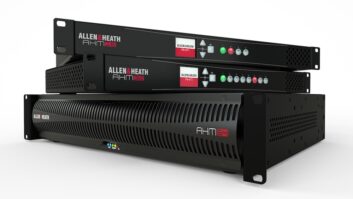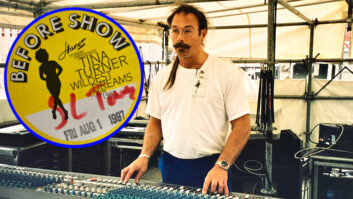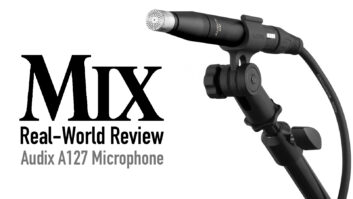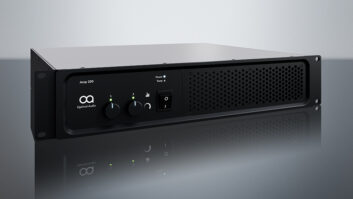The Audix D Series of dynamic microphones offers three powerful tools
when used for the right job. When I first encountered these instrument
mics, my reaction was, “Well which is the good one?” The D1
and D2 now list for only $199, and the D3 lists for $219, but that
doesn’t mean that the D3 is the best. Each has a unique
characteristic that, coupled with Audix’s outstanding sonic
quality, makes it appropriate for particular applications.
The D3, I was quick to find out, is perfectly suited for electric
guitar amps. It has a
response and sensitivity similar to the OM-7 vocal mic, and it is
really happy with a screaming Marshall stack or Fender Twin. Guitarists
who have spent a lifetime getting their “sound” just right
will be pleased by the clarity and transparency with which it places
their axe into the mix. While many popular choices for electric guitar
miking leave a little of their own tonal coloring, the D3 tends to let
the true sound of the rig ring out. Many times I was able to use this
mic “flat” and witness the guitarist’s surprise at
how good it sounded in the house. While the D3 is good for other live
sound applications where even tonal balance is needed, it shines on
electric guitar.
The D2 is a great mic for toms, all the way from large to small. Its
contoured response puts a little emphasis down low and up top, while
still letting the mids sound open and full. The D2 definitely gives
more “oomph” to the toms than the D3, which might be better
for percussion that is played more lightly. Compared to the D3, the D2
has more response below 160 Hz, a low-mid peak and a rising response to
about 4 kHz. I also used the D2 to great success with jazz kick drums
miked from the beater side, for horns and for bongos and congas.
Try the D1 on snare. The D1 is a special version of the D2
that’s had its response tilted to favor the high end. It is
extremely strong from 200 Hz up to 2k and lets a snare really cut
through a mix without overpowering it. The response of this mic
complements that of the D2—I also had success miking saxes and
trombones with the D2, while using D1s for trumpets. Others might
experiment using combinations of D Series mics on bi-amp bass rigs or
Leslie cabinets.
The D-flex is a $30 accessory that is cheaper and smaller than an LP
Claw and can be used for clamping the mics onto drum hardware. It is a
mic clip and a clamp, attached by a small, flexible-but-stiff
gooseneck. I also found it handy for miking guitars by clamping right
onto a combo amp’s handle. In many clubs, there are never enough
mic stands anyway. Bands roughing it in the support-act trenches may
find that using a few of these can make setting up in front of a
headliner on a small stage as simple as extending a few XLR connections to their
D Series mics. After the set, they’ll be asking, “Say, what
were those microphones?”
Many engineers reach for a standard selection of a few dynamics,
either out of habit or from what’s available in the mic box. Few
have the luxury of asking for esoteric products discovered in the
studio or glossy magazines, while the majority are forced into the same
old boring knee-jerk choices because they’ve worked in the past.
It’s sometimes difficult to find a reason to try a new microphone
when the time could be spent programming the effects or console. I have
been as guilty as the next engineer, but the reality is that several
good microphones can do more to improve a band’s sound than a
couple of rackmount boxes that cost many times more. And they’re
easier to carry with you, if not harder to keep track of at the end of
the night.
Though I continue to be a fan of Beyer, Sennheiser and Shure
instrument dynamics, I dare say that a handful of D Series mics might
just be the thing to put new life into the sound of your band.
Audix Corporation, www.audix-usa.com







